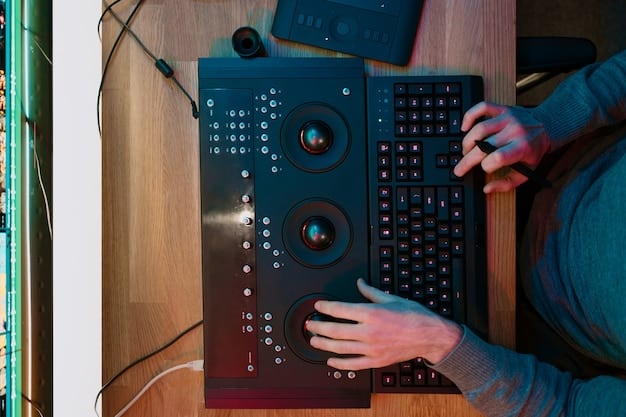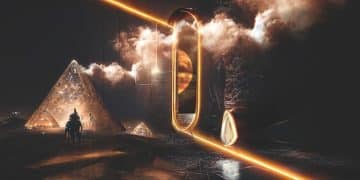Cult Classics’ Sound Secrets: What Modern Filmmakers Can Learn

Modern filmmakers can learn invaluable lessons from the often-overlooked sound design of cult classics, which masterfully employed forgotten audio techniques to create immersive, atmospheric, and unforgettable cinematic experiences, far beyond mere dialogue and music.
Delve into the auditory landscape of cinema’s most revered cult classics, as we explore how innovative and often overlooked audio approaches forged their distinctive identities. This exploration into Unearthing the Sound Design Secrets of Cult Classics: What Modern Filmmakers Can Learn from Forgotten Audio Techniques reveals how sound, rather than being a mere accompaniment, became a central pillar of their narrative and emotional impact. From subtle atmospheric cues to bold sonic experimentation, these films offer a masterclass in using audio to craft unforgettable cinematic worlds.
the foundation of immersive soundscapes: beyond dialogue and score
The role of sound in filmmaking frequently gets relegated to the background, serving primarily to support dialogue and musical scores. Yet, in the hands of visionary filmmakers and sound designers working on what would become cult classics, sound ascended to a protagonist status. These artists understood that the aural dimension could not only heighten emotions but also build entire worlds, often more effectively than visuals alone. They meticulously crafted soundscapes that pulled audiences deep into the film’s reality, creating a sense of presence and atmosphere that transcended simple plot points.
Modern cinema, with its reliance on rapid cuts and sometimes overwhelming visual effects, occasionally loses sight of this fundamental principle. Cult classics, however, frequently operated with tighter budgets, necessitating creative solutions. Sound became a potent, cost-effective tool for suggestion, terror, wonder, and psychological depth. It allowed them to imply rather than explicitly show, fostering a more active and imaginative engagement from the audience. This principle of immersive sonic storytelling is a cornerstone that today’s filmmakers can readily readopt.
the power of foley artistry in cult classics
Foley work, the reproduction of everyday sound effects for film, is an art form that reached its zenith in many cult classics. These films didn’t just add sound; they sculpted it. The deliberate creation of specific sounds, often using unconventional methods, imbued scenes with a unique tactile quality that made them memorable. Think of the unique squishing sounds in horror films or the distinct clanks and whirs of sci-fi machinery. These were not generic stock sounds.
- Tactile Authenticity: Foley artists used actual props and ingenious techniques to mimic real-world sounds, creating a palpable sense of reality.
- Emotional Resonance: Specific foley sounds were often exaggerated or stylized to enhance emotional impact, making scenes more intense or unsettling.
- World-Building Detail: From alien footsteps to the rustling of peculiar fabrics, foley provided granular details that enriched the film’s fictional universe.
This attention to detail, this almost obsessive pursuit of the “right” sound, is a lesson that transcends technological advancements. It’s about artistry and understanding how subtle auditory cues can profoundly affect perception. Modern digital tools offer unparalleled flexibility, but they should augment, not replace, the creative thinking behind foley.
Many classic low-budget films relied heavily on inventive foley to create effects that visual effects couldn’t afford. The sound of a monster’s breath, the creak of a haunted house, or a hero’s footsteps weren’t afterthoughts; they were integral design choices. The result was a heightened sensory experience that lingered long after the credits rolled. This thoughtful integration of foley is a technique often forgotten amidst the pursuit of pristine digital audio, yet it holds immense power for modern storytelling.
mastering silence and aural tension
Perhaps one of the most potent, yet under-utilized, tools in the sound designer’s arsenal is silence. In an age of constant auditory stimulation, the deliberate absence of sound can be profoundly unsettling and impactful. Cult classics, especially those within the horror and thriller genres, expertly wielded silence not as a void, but as a deliberate narrative device. It creates anticipation, amplifies vulnerability, and forces the audience to lean in, waiting for the inevitable sonic intrusion.
This strategic use of silence stands in stark contrast to the modern tendency to fill every sonic space. By allowing moments of quiet reflection or stark emptiness, these films elevated the sounds that *did* exist, making them resonate with greater force. It demonstrated an understanding that sound’s power is often defined by its absence, creating a dynamic range that keeps the audience on edge.
the art of sonic suggestion and ambient dread
Beyond absolute silence, cult classics also excelled at crafting ambient soundscapes that hinted at menace or wonder without explicitly announcing it. This “sonic suggestion” involves using subtle, often distorted or unfamiliar, background noises to create a pervasive mood. These weren’t jump scares; they were slow burns, burrowing into the subconscious of the viewer and fostering a sense of unease or mystery.
- Unseen Threats: Ambient sounds effectively suggest hidden dangers or unknown entities, tapping into primal fears.
- World-Specific Atmospheres: Each location in a cult classic often had its unique sonic fingerprint, from the hum of a spaceship to the distant cries of a forgotten cityscape.
- Heightened Tension: Sustained, low-frequency drones or barely perceptible whispers could elevate tension far more effectively than loud crashes.
Consider the unsettling hums in early sci-fi films or the almost imperceptible whispers in psychological thrillers. These weren’t just background noise; they were characters in themselves, subtly manipulating the audience’s emotional state. Modern filmmakers, with advanced spatial audio, have an even greater capability to create such immersive and suggestive sonic environments, if they choose to prioritize it.
The genius lay in using these techniques to make the audience feel, rather than just hear. The dread wasn’t just in the visual of a monster; it was in the echoing drips in a sewer or the distorted chimes in an old house. These forgotten audio techniques are not about technological limitations but about creative ingenuity – using sound to tell a story and envoke an emotional state.
innovative use of sound processing and effects
Long before digital audio workstations offered an endless array of plugins, pioneering sound designers in cult classics experimented with analog sound processing to create iconic and often bizarre effects. They pushed the boundaries of what was possible with tape manipulation, spring reverbs, filters, and early synthesizers, transforming mundane sounds into something otherworldly or terrifying. This era was characterized by a hands-on, experimental approach that often led to accidental discoveries and highly distinctive sonic palettes.
This willingness to experiment, to mangle and reshape sound in novel ways, stands as a testament to their creativity. Modern filmmakers, equipped with far more sophisticated tools, often default to off-the-shelf effects. Re-examining these older, more tactile methods can inspire a fresh wave of sonic innovation, moving beyond generic sound libraries to craft truly unique auditory experiences.

tape manipulation and early synthesis
Tape manipulation was a powerful, if laborious, technique. Reversing tapes, slowing them down, speeding them up, or cutting and splicing them in unconventional ways allowed sound designers to create alien voices, unsettling atmospheres, and unique rhythmic patterns. Early synthesizers, often clunky and monophonic, were also employed to generate unheard-of textures and abstract musical elements that became synonymous with certain genres, particularly sci-fi and horror.
- Unusual Textures: Tape speed variations and reverse effects produced sounds that were impossible to create naturally.
- Iconic Scores: Experimental electronic scores, often created with early synthesizers, defined the sonic identity of films like “A Clockwork Orange” or early John Carpenter works.
- Building Fear: Distorted voices and pitched-down effects on tape could render dialogue terrifying and eerie.
These techniques lent an organic, sometimes imperfect, quality to the sound that is difficult to replicate with pure digital precision. The “happy accidents” inherent in analog experimentation often gave these sounds their distinctive character. Modern filmmakers should explore how these foundational methods can be reinterpreted or hybridized with digital tools to forge truly unique auditory signatures.
The dedication to handcrafting these sounds, sometimes over grueling hours, resulted in an audio fidelity that, while not always “clean,” was deeply expressive and evocative. It proves that technological advancement isn’t always proportionate to creative impact. Sometimes, the constraints of older technologies force a level of ingenuity that leads to genuinely groundbreaking work.
the art of sound perspective and off-screen audio
Sound perspective, the manipulation of volume, timbre, and reverb to suggest distance and direction, is a fundamental technique often mastered by sound designers of cult classics. They understood that sound could articulate space, even when the visual frame was limited. By carefully crafting how sounds reached the audience – whether close and intimate or distant and muffled – they controlled perception and immersion. This concept goes hand-in-hand with the masterful use of off-screen audio.
Off-screen sound, sounds whose source is not visible within the shot, is a suspense-building tool par excellence. It expands the film’s world beyond the visible frame, suggesting events, characters, or threats just out of sight. Cult classics frequently used this to great effect, leveraging the audience’s imagination to fill in the blanks, often with results far more terrifying or wondrous than any visual could achieve.
creating worlds through invisible sounds
The use of sound to define space and suggest an unseen world is a powerful, yet often subtle, technique. Whether it’s the distant rumble of a monster, the chatter of an unseen crowd, or the eerie silence beyond a door, off-screen sound expands the narrative canvas. It encourages active listening and interpretation, making the audience a more engaged participant.
- Expanding the Scene: Off-screen sounds imply a larger world outside the frame, adding depth and realism.
- Building Suspense: Unseen threats are often scarier, with off-screen noises fostering a sense of dread and anticipation.
- Character Presence: The sound of a character approaching or breathing nearby, even if not seen, heightens their presence.
Think of the terrifying screech outside the window in a horror film or the distant, distorted radio communication in a sci-fi epic. These sounds are not just ambient; they are narrative drivers, guiding the audience’s attention and emotion. Modern filmmakers, with more sophisticated multi-channel audio systems, have an unprecedented ability to create incredibly detailed and believable sound perspectives, but only if they choose to be as deliberate as their predecessors.
The restraint in showing, combined with the abundance of suggestive audio, allowed these cult classics to create a powerful sense of an unseen reality. It’s a reminder that sound can be a guide, a warning, or an invitation, shaping the audience’s understanding of the narrative space far beyond what the camera frames. This deliberate omission of full sensory information, favoring suggestions, is a forgotten art.
sound as a character: giving voice to the otherworldly
In many cult classics, sound wasn’t just background or effect; it was a character in itself. This is particularly evident in science fiction and horror, where creating the “voice” of an alien creature, a malevolent spirit, or a sentient machine was paramount to its identity. These filmmakers went to extraordinary lengths to craft unique sonic signatures for their non-human characters, making them instantly recognizable and often terrifying or iconic.
This approach transforms sound from a passive element into an active participant in the storytelling. By imbuing these characters with distinct auditory traits, they become more memorable, more believable, and more potent within the narrative. Modern filmmakers, with access to endless sonic palettes, could learn from this dedicated characterization through sound, moving beyond generic monster roars or digital bleeps.
crafting signature sounds for creatures and entities
The process of giving a voice to the otherworldly often involved extensive experimentation with animal sounds, industrial noises, human vocalizations, and early electronic synthesis. These elements were then layered, processed, and distorted to create something truly unique and terrifying. The goal was to avoid anything that sounded overtly human or familiar, pushing the boundaries of auditory discomfort and wonder.
- Distinctive Identities: Unique sounds gave non-human characters a recognizable and memorable presence.
- Emotional Impact: The specific quality of a creature’s sound could convey menace, sadness, or alien intelligence.
- Psychological Resonance: Strange, unfamiliar sounds tap into primal fears of the unknown, making creatures more frightening.
Think of the iconic roars of classic movie monsters or the eerie chirps and clicks of alien beings. These sounds are not only part of the film’s atmosphere but are fundamental to the creature’s identity. They tell a story about its nature, its temperament, and its threat level, all without a single word of dialogue. This level of sonic character design is a forgotten art form that modern filmmakers could greatly benefit from rediscovering.
The careful attention paid to an alien soundscape or a creature’s vocalizations was not merely decorative. It was essential for suspending disbelief and making the fantastical feel real. This deep dive into sonic character development demonstrates a profound understanding of how sound affects perception and emotional response, a lesson that retains its power in contemporary filmmaking.
the interplay of music and effects: forging unique moods
Cult classics often blurred the lines between musical score and sound effects, creating a seamless and immersive auditory experience. Instead of distinct separation, these films frequently integrated ambient sonic textures, processed noises, and non-traditional musical elements directly into the score, or vice-versa. This integration resulted in a mood that was often unsettling, dreamlike, or intensely atmospheric, making music an active participant in the soundscape rather than a separate entity.
This holistic approach to audio design allowed for a greater depth of emotional manipulation. By weaving musical motifs into environmental sounds or treating effects almost like percussive elements, these films forged unique emotional connections with their audience. Modern productions, often following more rigid conventions, could significantly benefit from revisiting this fluid interconnection between score and effects.
experimental scores and non-traditional instrumentation
Many cult classics are renowned for their boundary-pushing musical scores. Composers often collaborated directly with sound designers, employing non-traditional instruments, synthesizers, and found sounds to create scores that were as much about texture and atmosphere as they were about melody. This experimental spirit led to truly iconic and genre-defining soundtracks.
- Atmospheric Fusion: Scores often incorporated sound effects, making the music feel like an organic part of the film’s world.
- Genre Redefinition: Experimental scores pushed boundaries, influencing entire genres of filmmaking.
- Emotional Depth: The fusion of music and sound effects created complex and nuanced emotional landscapes.
Think of the minimalist, synth-heavy scores of John Carpenter, where the music itself feels like an oppressive presence, or the avant-garde compositions in some psychological thrillers that merge industrial sounds with orchestral elements. These weren’t just background tracks; they were integral to the film’s identity and emotional core. The willingness to experiment with sound and music in such a cohesive way is a valuable lesson for today’s filmmakers.
The integrated approach allowed for a kind of sensory overload that was both deliberate and highly effective. The boundaries between “what you heard” and “what you felt” often dissolved, leaving the audience with an indelible impression. This kind of sophisticated sonic tapestry is a hallmark of truly innovative filmmaking and needs to be brought back into contemporary practice.
redefining narrative through unconventional sound choices
Ultimately, what sets the sound design of cult classics apart is their audacious willingness to make unconventional sound choices that directly served the narrative. They didn’t just support the story; they actively shaped it, often communicating subtext, foreshadowing, or internal states that visuals alone couldn’t convey. This meant taking risks, using sounds in unexpected ways, and prioritizing artistic expression over strict realism.
Modern filmmakers, often constrained by commercial pressures or a desire for pristine realism, sometimes miss opportunities for such impactful sonic storytelling. Re-examining the fearless experimentation of these forgotten audio techniques can unlock new dimensions of narrative expression, allowing sound to transcend its traditional role and become a leading voice in the cinematic experience.
subverting expectations with sound
Cult classics often used sound to deliberately subvert audience expectations, creating moments of shock, humor, or profound emotional resonance. This could involve misdirection, where a sound leads the audience to anticipate one thing, only for a different outcome to occur, or using a familiar sound in an entirely alien context to create discomfort.

- Narrative Foreshadowing: Subtle sound cues often hinted at future events or character developments.
- Psychological Resonance: Abstract or distorted sounds could represent a character’s mental state or an unseen force.
- Symbolic Audio: Specific sounds sometimes carried symbolic weight, adding layers of meaning to the narrative.
Consider the use of unsettling child’s toys juxtaposed with genuinely terrifying scenes, or the complete absence of expected sounds in moments of extreme violence, creating a jarring, surreal effect. These choices were deliberate and designed to evoke a strong, often visceral, response. This fearless narrative manipulation through sound is a powerful lesson in breaking conventions.
The courage to use sound as a primary narrative driver, taking it beyond a supporting role, defines much of the enduring appeal of cult classics. It reminds us that sound is not just what we hear, but what we feel and how we understand the story. By re-embracing these forgotten techniques, modern filmmakers have the opportunity to craft a truly unique and memorable auditory legacy, echoing the masters who came before them.
| Key Learning | Brief Description |
|---|---|
| 🔊 Immersive Foley | Craft detailed, tactile sounds using ingenious foley methods to enhance realism and emotional depth. |
| 🤫 Strategic Silence | Utilize silence as a narrative tool to build tension and emphasize subsequent audio cues, rather than filling every space. |
| 👽 Character-Driven Audio | Design unique, iconic sonic identities for non-human characters and environments through experimental processing. |
| 〰️ Integrated Soundscapes | Blend music and sound effects seamlessly into a cohesive, mood-defining auditory tapestry. |
frequently asked questions about cult classic sound design
Foley artistry involves creating and adding everyday sound effects to film, like footsteps or prop movements, during post-production. It was crucial for cult classics because it provided a tactile authenticity and emotional resonance that enhanced immersion, especially for films with limited budgets where visual effects couldn’t always convey the desired impact.
Cult classics masterfully employed silence not as just an absence of sound, but as a deliberate narrative tool. By strategically omitting sound, they built anticipation, amplified feelings of vulnerability, and forced audiences to actively engage, making subsequent sounds more impactful and unsettling, a technique often overlooked today.
Modern filmmakers can learn from the experimental, hands-on approach to sound processing. Analog techniques like tape manipulation, spring reverbs, and early synthesizers led to unique, organic textures and “happy accidents” that are distinct from digital effects. Reinterpreting these methods can inspire truly original and non-generic sonic palettes.
Off-screen audio played a significant role by expanding the film’s world beyond the visual frame. It suggested unseen threats, characters, or events, leveraging the audience’s imagination to create suspense, dread, or wonder more effectively than showing everything explicitly, thus deepening the narrative’s psychological impact.
Integrating music and sound effects, as seen in many cult classics, creates a seamless, immersive auditory experience. By blurring the lines between score and ambient sounds, filmmakers can forge unique moods and manipulate emotions more profoundly, leading to a richer, more cohesive, and memorable cinematic experience that transcends traditional sound design.
conclusion
The journey through the sound design of cult classics is a powerful reminder that audio is far more than an accessory to visuals; it is a fundamental pillar of cinematic storytelling. From the meticulous detail of foley to the profound impact of intentional silence, and from experimental sound processing to the characterization through sonic signatures, these films provide an invaluable blueprint. Modern filmmakers have an unprecedented array of tools at their disposal, but the true lesson from these forgotten audio techniques lies not in technological prowess, but in creative courage, artistic intention, and the profound understanding of how sound can shape perception, emotion, and narrative. By revisiting and reinterpreting these lessons, today’s creators can elevate their craft, enriching the cinematic experience for audiences, and perhaps, create the cult classics of tomorrow, grounded in a respect for the power of what we hear.





